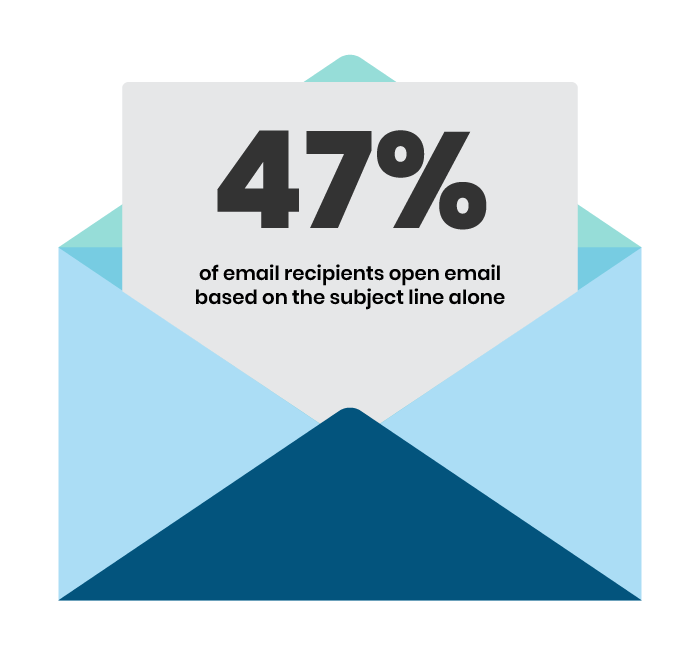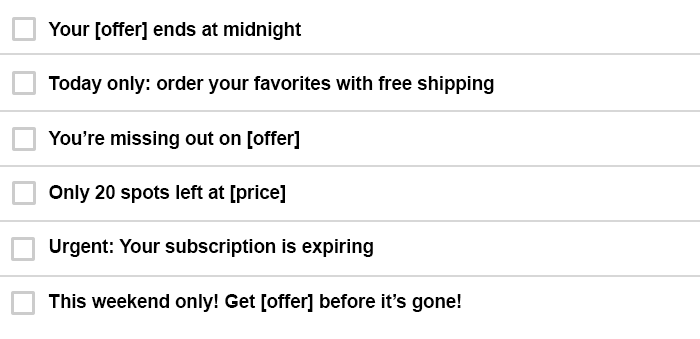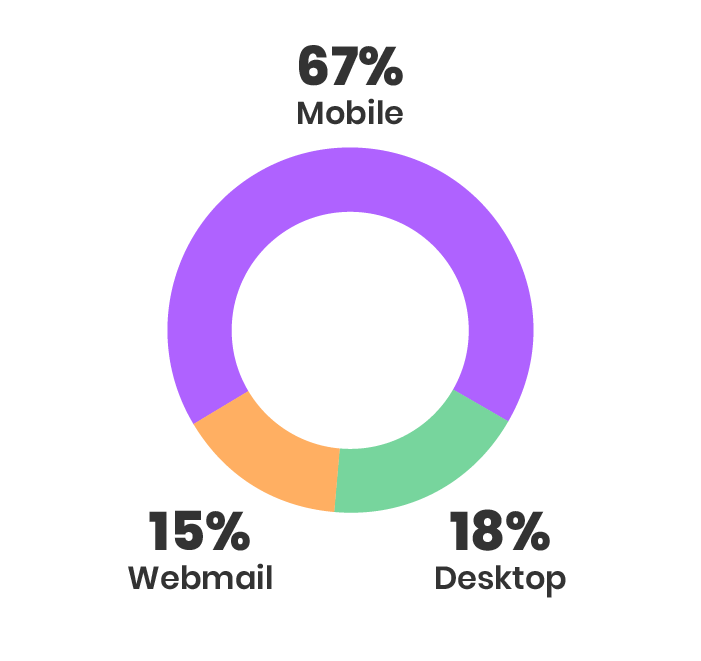
Before it hit shelves, F. Scott Fitzgerald’s The Great Gatsby was almost titled The High-Bouncing Lover.
Doesn’t have the same ring to it, huh?
Writing your email subject line is a lot like choosing a book title: You have to get it right, or people may never open it — no matter how fantastic the content is inside.
In fact, 47% of email recipients admit to opening email based on the subject line alone.

One of the most common questions we hear is: “what do I write in the subject line of an email?” Many people wonder how to write perfect email subject lines.
While there’s no single formula to create the best subject lines for email marketing, the following battle-tested guidelines will get you pretty close to perfect. They can help you make your messages even more appealing to your subscribers.
Apply them to your email subject lines, and you could be the next Fitzgerald of the inbox.
(Looking for an email service provider that lands you in the inbox — and not the spam folder? Get AWeber Free today! We have 20 years of industry-leading deliverability!)
Email Subject Line Best Practices
Your subject line can single-handedly make or break your entire email campaign. We put together this list of best practices to help you create attention-grabbing subject lines for your email marketing campaigns.
Personalize your email subject lines
Here’s some emails I recently received:

Did any of them make me feel special? Not particularly.
Many years ago when companies first started using first name personalization, it worked. It grabbed your attention. But now, variations of “Hello {!firstname_fix}” have become the norm in email marketing, not the outlier. Because of that, it’s lost its novelty.
But that’s not the type of personalized email subject line I’m talking about. To truly create an email subject line that gets attention, you need to make the content unique to that individual subscriber.
You need to go above and beyond to connect with each customer. You can do this by personalizing your message based on location, past purchase behavior, and content they’ve engaged with. Think of what information you have on your customers. Now use that to create a personalized experience for them.
What if I took the same email blast subject lines examples above, but made them personalized based on my experiences with those brands?

Now that made a difference.
So what’s the best way to accomplish this? With your next email subject line best practice - segmentation.
How to use segmentation
At AWeber, we recommend segmenting your audience and sending each segment tailored messages with unique subject lines.
“You can craft an open-worthy email by appealing to an individual’s interests. People enjoy emails relevant to their wants and needs,” says Shayla Price, a B2B marketer.
Here are some ways to do just that:
- Ask questions on your sign up form.
Then use that information in your email subject lines. For example, if you write a fashion blog, you can ask your subscriber for his or her favorite color when they sign up to your mailing list. Then, you can send them emails based on their color choice — like “15 gorgeous [color] dresses under $50.” - Send location-based emails.
Traveling to a conference? Speaking at an event? Meet up with your subscribers in different cities. “We’re in [city] next week! See you there?” - Retarget subscribers.
Did a subscriber abandon a product in his or her shopping cart? You could send an email like “Forget something? Here’s a 20% off coupon!” Or did a subscriber not follow through on an action, like registering for your webinar or workshop? Use that info to tailor their next message. “Only 12 hours to sign up for [event]!”
Create urgency in your subject line with FOMO
Fear of missing out — or FOMO — is a powerful psychological driver of email opens and engagement. Email subject lines that create a sense of urgency, scarcity, and exclusivity can boast a 22% higher open rate.
This can be done by giving your subscribers a deadline to accomplish an action.
Here are some other effective FOMO email subject line examples:

Avoid spam triggers in your subject line
Email spam filters are triggered by specific words, phrases, and symbols in your subject line and email content. AWeber uses a content filtering tool called SpamAssassin™ to help you avoid content filtering. This tool is widely used by internet service providers (ISPs) to filter incoming email.

By clicking on that score, you can instantly view the content in your messages that are triggering the SpamAssassin™ ruleset.
So what are some words, phrases, and symbols that are red flags to spam filters? There are a ton, but here’s a few to give you an example:
- Excessive punctuation like multiple exclamation points!!!!!!! or ellipses ………
- TYPING IN ALL CAPS
- Symbols like “$$$” and “*****”
- Phrases like “cheap,” “cash off,” “incredible deal,” “satisfaction,” “winner”
Also, as many as 69% of email recipients report email as spam based solely on the subject line. Make sure your subject line doesn’t come across as spammy to your subscriber, too. This will happen if your subject line is deceiving in any way, such as leading with “RE:” when it’s not an actual reply to an email.
Be direct in your subject line
Skip the wit, wordplay, humor, rhymes, or puns in your subject lines.
Stick with straightforward headlines instead. These “boring” subject lines convert extremely well. That’s because they explain the value inside the email. The readers know exactly what to expect from the message and the benefits they’ll receive from opening it.
Here are some straightforward email subject line examples:

But there’s one catch: Your messages have to consistently provide value. If your messages fall short of their promised value, your subscribers will feel cheated. Then, good luck getting them to open your messages moving forward.
However, if your emails are constantly packed with important, personalized content, your audience will open your emails — no matter what the subject line says.
Ask questions to pique curiosity
There’s a reason most television season finales end with cliffhangers: Humans crave nice-and-neat endings. So when you don’t give it to them, they’re unsettled. They have to know what happens next, and they’ll tune in the next season for closure.
Use this craving to your advantage. Fuel your subscribers to open your emails by injecting curiosity into your subject lines. You can ask a question:
- Jo at Copy Hackers: “Are you missing these 3 copy techniques?”
- Men’s Health Daily Dose: “Will Creatine Boost Your Gains?”
Or promise an answer inside your message:
- Jessica Stansberry: “You should be going live ___ times per month! [open for the answer]”
- Sophie Gray: “This is the ONLY Reason You Should Workout”
Or tease a surprise, giveaway, or gift:
- AWeber Blog: “We made free Fall GIFs for you!”
Or make readers say “huh?!”
- Chubbies: “Sincerely, future Dwight”
- Really Good Emails: “Emails can be tasty “
Added Tips for Writing Email Subject Lines
Email subject line tip #1: character length
How long should your email subject line be?
No one can agree.
Litmus recommends around 50 characters. Yes Lifecycle Marketing says emails with subject line up to 20 characters have the highest average open rate, unique click rate, and click-to-open rate. An analysis from Retention Science found that subject lines with 6 to 10 words results in the highest open rates. And Return Path advises using 61 to 70 characters.
So in reality . . . it depends. (Sorry, I know that’s no one’s favorite answer.) Every industry — and audience — is different.
But here are some important things to keep in mind when you’re testing various subject line lengths — no matter what industry you’re in:
- Do most people open your emails on desktop or mobile? It’s estimated that over 67% of readers are opening their emails on a mobile device. If you find your list trending toward mobile, too, then aim for short email subject lines (35 characters or less).

- Is your preheader text cut off? If so, will your subject line still make sense without it?
- Are there words you can cut to be more concise or clear?
- Is your message clear and direct?
Email subject line tip #2: use emojis
In a busy inbox, an emoji (or a special character, like a carat ^, hashtag #, or tilde ~) can stand out. In fact, emojis may increase your open rates by 29%.
- AWeber Blog: “Why you need a hook 🎣”
At AWeber, we use emojis in our messages every so often to pack a punch, or to shorten a subject line. For instance, we might use a 💡 instead of writing out the word lightbulb to keep the entire subject line visible on mobile devices.
Some emojis look very different from one Internet Service Provider (ISP) to the next. So don’t forget to test your emails in various ISPs like Gmail, Hotmail, and Yahoo!, too. Here are 3 Ways to Test Your Emails Before Hitting ‘Send.’
If you choose to use emojis, beware: Emoji usage in marketing messages is on the rise. So there’s a chance your emoji may not stand out as much as you’d like. Our advice: Test them with your readers. See if your readers act positively to emojis through increased open rates.
What’s next?
There’s no single formula for writing the most successful email subject lines. But if you mix-and-match the subject line rules and tips above, you’ll be able to optimize your open rates over time and come up with a formula that works extremely well with your audience.
To find out which types of subject lines your audience likes best, run an A/B split test. Leverage what works, then test again. The type of subject line that works for your audience today might not be as effective six months from now. Watch your open rates closely so you can adapt and improve.
Want to try out a new subject line today? Log in to your AWeber account to get started. Don’t have an AWeber account yet? Get AWeber Free today!
I’d love to hear from you, what was one of your best eblast subject lines that worked?
Post written by contributing writer Marijana Kay and Sean Tinneysource https://blog.aweber.com/email-marketing/your-guide-to-writing-the-worlds-best-email-subject-lines.htm
No comments:
Post a Comment